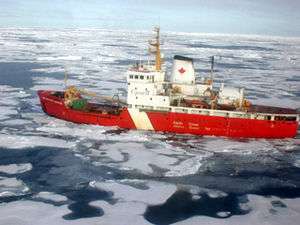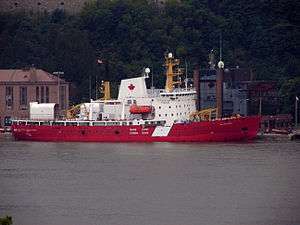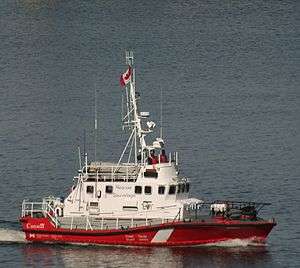List of equipment of the Canadian Coast Guard
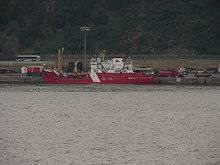
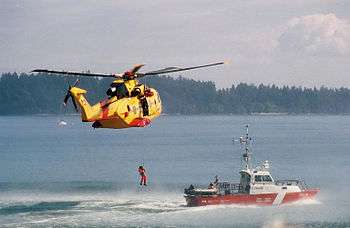

The Canadian Coast Guard (CCG) maintains a fleet of sea and lake going vessels, hovercraft, and aircraft. The variety of equipment allows the CCG to perform its mandated functions of navaids and sea-going transportation management, search and rescue, marine pollution response and the support of other Canadian federal authorities.
Vessels
The Fleet Directorate is responsible for all ships and their manning requirements. It manages and operates a fleet of 118[1] vessels in support of: CCG aids to navigation; icebreaking; environmental response; and search and rescue (SAR). The CCG fleet also supports Department of Fisheries and Oceans's Fisheries Conservation and Protection and Marine Science programs.
The ships, ranging from search and rescue lifeboats to icebreakers, are tasked to various programs, often concurrently, and are crewed by 2400 skilled seagoing personnel. Most vessels have between 5 and 30+ crewmembers.
All CCG vessels are painted uniformly regardless of their use. They are characterized by a red hull and white superstructure, designed to look like a "floating Canadian flag". Their hulls bear a (primarily) white stripe raked forward at a 60 degree angle on each side forward. Larger vessels display a red maple leaf on the funnel. Ship nameplates are typically affixed to the superstructure, and vessels are typically named for persons or places of historic or geographic significance.
Throughout the 1960s—1990s, the CCG painted primary SAR vessels in a different colour scheme: bright mustard yellow superstructure and maple leaf red hull, meant to distinguish them from navaid tenders and icebreakers, and also to improve their visibility on the open ocean in breaking waves. Today, the only distinguishing markings for primary SAR vessels is the large RESCUE-SAUVETAGE lettering on the superstructure. Vessels carry the "Canada" 'federal wordmark', which incorporates the duotone version of the national flag. The words Coast Guard/Garde Cotière appear side by side on the hull.
The prefix "Canadian Coast Guard Ship", abbreviated CCGS, is affixed to all vessels. Minor vessels such as patrol boats and lifeboats carried the prefix "Canadian Coast Guard Cutter", abbreviated CCGC in the past, however, this is no longer the case.
The list of various classes of CCG vessels includes:
Polar icebreaker
- A very large multitasked icebreaker, approximately 140 metres (460 ft) in length, capable of sustained operations in the Arctic Archipelago over three seasons per year. Has a large cargo carrying capacity, a helicopter hanger that will accommodate two CCG helicopters, and carry multiple utility craft. Has the capacity to over-winter in the Arctic, and the capacity to deliver a large suite of Government of Canada programs. Named after former Canadian prime ministers.
- CCGS John G. Diefenbaker (planned)
Heavy icebreaker
- A very large multitasked icebreaker, approximately 130 metres (430 ft) in length, capable of sustained operations in the Arctic Archipelago over two seasons per year and for escort operations in the Gulf of St. Lawrence and East Coast of Newfoundland. Has a large cargo carrying capacity, a helicopter hanger that will accommodate a CCG helicopter, and carry multiple utility craft. Named after former Canadian prime ministers. Formerly referred to as Type 1300.
Medium icebreaker
- A large icebreaker, approximately 100 metres (330 ft) in length, capable of sustained icebreaking and escort operations in the in the Arctic Archipelago over two seasons per year, the Great Lakes, St. Lawrence River and Gulf of St. Lawrence and Atlantic Coast in winter. Has a cargo carrying capacity, a helicopter hanger that will accommodate a CCG helicopter, and carry multiple utility craft. Has the capability to deliver many Government of Canada programs such as many CCG programs and scientific missions. Named after former Canadian prime ministers. Formerly referred to as Type 1200.
High endurance multi-tasked vessel
- A large highly adaptable multi-tasked vessel, approximately 85 metres (279 ft) long, with an icebreaking capability to work in the southern and western Arctic, for escort operations in the Great Lakes, St. Lawrence River and Gulf of St. Lawrence and Atlantic Coast in winter. Has a shallower draught than the medium icebreaker and is less capable overall. Has a crane, a large cargo hold and deck capacity, has a helicopter hanger that will accommodate a CCG helicopter, can launch and recover rigid-hull inflatable boats and two utility craft. Has the capability to deliver many Government of Canada programs. Named after former Canadian Governors General. Formerly referred to as Type 1100.
- CCGS Griffon
- CCGS Ann Harvey
- CCGS Edward Cornwallis
- CCGS George R. Pearkes
- CCGS Martha L. Black
- CCGS Sir Wilfrid Laurier
- CCGS Sir William Alexander
Offshore oceanographic science vessel
- A large multitasked offshore noise-reduced vessel, approximately 90 metres (300 ft) long, capable of extended missions of four to six weeks with a 10,000 nautical miles (19,000 km; 12,000 mi) range, no icebreaking capabilities but able to operate in ice infested waters. Equipped with wet labs and has bottom sampling and water column sampling capability, can accommodate a helicopter with minimal hanger capabilities and can launch and recover utility craft. Primarily used for ecosystem and fishery science, oceanographic missions and geological and hydrographic surveys. Named after former Canadian scientists or explorers who have made a significant contribution.
- CCGS Hudson
- CCGS John P. Tully
- One unnamed vessel to replace Hudson
Offshore fishery science vessel
- A large multitasked offshore noise-reduced vessel, approximately 55 to 65 metres (180 to 213 ft) long, capable of extended missions of four to six weeks with a 8,500 nautical miles (15,700 km; 9,800 mi) range, no icebreaking capabilities but able to operate in ice infested waters. Equipped with wet labs and able to do trawl surveys and has some water column sampling capability, no helicopter capabilities. Primarily used for ecosystem and fishery science research. Named after former Canadian scientists or explorers who have made a significant contribution.
- CCGS Alfred Needler
- CCGS Teleost
- CCGS W.E. Ricker
- CCGS Sir John Franklin (2017)[2]
- Two unnamed vessels (2018)[2]
Medium endurance multi-tasked vessel
- A large multi-tasked shallow draught vessel, approximately 65 metres (213 ft) long, with a top speed of 14 knots (26 km/h; 16 mph) that can stay at sea up to 28 days. Has a crane, a large cargo hold and deck area, can launch and recover rigid-hull inflatable boats and utility craft. Primarily used for aids to navigation, search and rescue, science and environmental response and has some icebreaking capability. Designed to have a helicopter deck but not generally equipped with one. Named after former Canadian mariners or members of the CCG who have made a significant contribution. Formerly referred to as Type 1050 and 1000.
- CCGS Bartlett -buoy tender
- CCGS Earl Grey
- CCGS Samuel Risley
Offshore patrol vessel
- A large offshore vessel, approximately 75 metres (246 ft) long, that can operate beyond 120 nautical miles (220 km; 140 mi) including outside the Exclusive Economic Zone, has a top speed greater than 20–25 knots (37–46 km/h; 23–29 mph) and can stay at sea for up to six weeks. Can operate year-round in Canadian waters, except the Arctic archipelago, and has a minimal ice capability to transit light ice-infested waters. Carries two rigid-hulled inflatable boats, up to 11 metres (36 ft) long, can accommodate a helicopter with minimal hanger capabilities. Designed to support law enforcement, and has a program operations room. Primarily used for fisheries enforcement and search and rescue. Named after Former Companions of the Order of Canada.[3]
- CCGS Cape Roger
- CCGS Cygnus
- CCGS Gordon Reid
- CCGS Leonard J. Cowley
- CCGS Sir Wilfred Grenfell
- CCGS Tanu
Mid-shore patrol vessel
- A medium sized vessel, approximately 40 metres (130 ft) long, that can operate up to 120 nautical miles offshore with a top speed of 25 knots and stay at sea up to 14 days. No requirement for operations in ice-infested waters. Carries one or two rigid-hull inflatable boats with no helicopter capabilities. Primarily used for maritime security and fisheries enforcement. Named after former winners of the Victoria Cross, Star of Military Valour, Medal of Military Valour, Meritorious Service Medal, Star of Courage, Medal of Bravery, Order of Merit of the Police Forces, Royal Canadian Mounted Police Role of Honour of Department of Fisheries and Oceans or CCG members who died in the line of duty.
- CCGS A. LeBlanc
- CCGS Atlin Post
- CCGS Caporal Kaeble V.C.
- CCGS Captain Goddard M.S.M.
- CCGS Constable Carrière
- CCGS Corporal McLaren M.M.V.
- CCGS Corporal Teather C.V.
- CCGS G. Peddle S.C.
- CCGS M. Charles M.B.
- CCGS Private Robertson V.C.
Mid-shore science vessel
- Medium sized vessel, approximately 40 metres long, capable of sustained operations away from port for up to 14 days, has endurance for 21 days and a top speed of 12–14 knots (22–26 km/h; 14–16 mph) with a cruising range of 4,000 nautical miles (7,400 km; 4,600 mi), has minimal ice capability to transit light ice-infested waters. No helicopter capability and limited capacity to carry survey launches. Primarily used for limited ecosystem fishery science, oceanographic missions and geological/hydrographic surveys. Named after former Dominion hydrographers of Canada or former explorers of Canada.
- CCGS Frederick G. Creed
- CCGS Limnos
- CCGS Otter Bay
- CCGS Vector
Special navaids vessel
- A shallow-draft, flat-bottom vessel, approximately 50 metres (160 ft) long, self-supporting for up to 28 days and can sustain repeated groundings due to shifting river channels, not suitable for open-sea work, no icebreaking capabilities. Can accommodate a helicopter with minimal hanger capabilities. Primarily used for navigational aids on the Mackenzie River. Named with Aboriginal words.
- CCGS Dumit
- CCGS Eckaloo
Near-shore fishery research vessel
- Small, approximately 20–25 metres (66–82 ft) long, fishery research vessel with a 3–4 metres (9.8–13.1 ft) draught, a speed of 12 knots with a moderate range. Has minimal ice capability to transit light ice-infested waters. Has some lab capacity and has no helicopter capability. Used to conduct trawl surveys. Named after former Canadians who have made a contribution to marine and fishery research or fisheries management.
- CCGS Leim
- CCGS M. Perley
- CCGS Neocaligus
- CCGS Vladykov
Channel survey and sounding vessel
- Small vessel, approximately 20-25 metres long, with sounding speed of 10 knots (19 km/h; 12 mph) with no ice capability. Carries a small utility craft and has no helicopter capability. Primarily used to conduct depth survey operations. Named after former Dominion hydrographers of Canada or former explorers of Canada.
- CCGS F.C.G. Smith
- CCGS GC-03
Air cushion vehicle (hovercraft)
- A medium-sized, fast hovercraft, up to 45 knots (83 km/h; 52 mph), multi-tasked vessel which rides on a cushion of air, capable of working in very shallow areas and littoral zones. Has no helicopter capability. Primarily used for search and rescue, aids to navigation, environmental response and icebreaking. Named with Aboriginal words.
SAR lifeboat (MLBs)
- Small, approximately 15 to 17 metres (49 to 56 ft) long, shore-based self-righting lifeboat capable of search and rescue operations up to 100 nautical miles (190 km; 120 mi) from shore with a top speed of approximately 25 knots with minimal ice capability to transit light ice-infested waters. No helicopter capability. Named after geographical features uniform by class. Canadian capes for high speed lifeboats (47 feet (14 m) MLBs). Canadian bays for high endurance lifeboats (Arun/Severn design). CCG maintains 36 14.6-metre (47 ft 11 in) Cape-class motor lifeboats, those listed with the name prefix Cape (or Cap in french). The exception is CCGS Cap Aux Mueles which is one of ten larger (16 metres (52 ft)) motor lifeboats based on Arun-class lifeboats designed in the United Kingdom. The CCG is in the process of building replacements for the Arun type lifeboats based on the Severn type lifeboat also designed in the United Kingdom.


- CCGS Bickerton
- CCGS Cap Aupaluk
- CCGS Cap Aux Meules
- CCGS Cap Breton
- CCGS Cap D'Espoir
- CCGS Cap De Rabast
- CCGS Cap Nord
- CCGS Cap Percé
- CCGS Cap Rozier
- CCGS Cap Tourmante
- CCGS Cape Ann
- CCGS Cape Calvert
- CCGS Cape Caution
- CCGS Cape Chaillon
- CCGS Cape Cockburn
- CCGS Cape Commodore
- CCGS Cape Dauphin
- CCGS Cape Discovery
- CCGS Cape Dundas
- CCGS Cape Edensaw
- CCGS Cape Farewell
- CCGS Cape Fox
- CCGS Cape Hearne
- CCGS Cape Kuper
- CCGS Cape Lambton
- CCGS Cape McKay
- CCGS Cape Mercy
- CCGS Cape Mudge
- CCGS Cape Naden
- CCGS Cape Norman
- CCGS Cape Palmerston
- CCGS Cape Providence
- CCGS Cape Rescue
- CCGS Cape Spry
- CCGS Cape St. James
- CCGS Cape Storm
- CCGS Cape Sutil
- CCGS Clarks Harbour
- CCGS Courtney Bay
- CCGS Sambro
- CCGS Spindrift
- CCGS Spray
- CCGS Thunder Cape
- CCGS W.G. George
- CCGS W. Jackman
- CCGS Westport
Specialty vessel
- Small, under 150 GRT, shallow-draft vessel of various designs with no ice capability. Generally has no accommodation with a crew compliment that is specific to tasks the vessel performs. No helicopter capability. Used for marine and fishery research, conservation and protection patrols, science and aids to navigation. Named after Former Canadians who have made a contribution to marine and fishery research or fisheries management or maritime safety or security or marine transportation.
- CCGS Cape Light
- CCGS Caribou Isle -small buoy tender
- CCGS Cove Isle -small buoy tender
- CCGS Geliget
- CCGS Harp
- CCGS Île Saint Ours -small buoy tender
- CCGS Kelso
- CCGS Kode & Kin
- CCGS Pointe Caveau
- CCGS S. Dudka
- CCGS Sigma T
- CCGS Traverse -river buoy tender
- CCGS Vakta
- CCGS Viola M. Davidson
Training vessels
- Vessels used for training at the Coast Guard College.
Small/utility craft
- CCG employs various makes and models of small craft, generally less than 15 GRT, 12 metres (39 ft) long or less, aboard ships and at shore stations for utility and search and rescue tasks. Large vessels carry work boats such as Rotork Marine's Sea Truck design, similar to small landing craft, which are deployed by davits and used for delivering supplies ashore to light stations and remote communities. Rigid-hulled inflatable boats equipped with outboard or inboard engine propulsion systems are deployed aboard CCG ships or at shore stations as tenders and as fast rescue craft (FRC) for utility and search and rescue tasks. These vessels are not named.
- Work boats
- Roseborough Boats RF-246 designs
- Rotork Marine Sea Truck designs
- Rigid hull inflatable boats (RHIBs)
- Zodiac Hurricane Mark IV, Mark V, Mark VI, 733 and 753 SOLAS designs
- Roseborough Boats Rough Water 9.11 SOLAS designs
- There are also two new 40-foot (12 m) high-speed, aluminum Kingston-class search and rescue and environmental patrol boats built by Metalcraft Marine going into Arctic service.
Retired vessels
The following is a listing of vessels that are no longer part of the Canadian Coast Guard's present fleet.
- CCGS A.H. Chevarie
- CCGS Advent
- CCGS Alexander Henry
- CCGS Arrow Post -July 2016 - vessel has been transferred to Parks Canada - name to be changed
- CCGS CG 117 -retired
- CCGS CG 118 -retired
- CCGS CG 119
- CCGS Calanus II -Decommissioned
- CCGS Cape Hurd - now retired and owned by Toronto Fire Services
- CCGS Cumella
- CCGS E.P. Le Québécois
- CCGS G & D Mallard
- CCGS Gull Isle
- CCGS Île des Barques
- CCGS Isle Rouge
- CCGS J.E. Bernier
- CCGS Kitimat II
- CCGS Louis M.Lauzier
- CCGS Louisbourg
- CCGS Matthew
- CCGS Miskanaw
- CCGS Montmagny
- CCGS Nahidik
- CCGS Narwhal
- CCGS Opilio
- CCGS Pandalus III
- CCGS Parizeau
- CCGS Partridge Island
- CCGS Point Race
- CCGS Point Henry
- CCGS Porte Dauphine
- CCGS Provo Wallis
- CCGS R.B. Young
- CCGS Revisor
- CCGS Shamook
- CCGS Shark
- CCGS Simcoe
- CCGS Simmonds
- CCGS Simon Fraser
- CCGS Sir Humphrey Gilbert
- CCGS Skua
- CCGS Sooke Post
- CCGS Spilsbury
- CCGS Sterne
- CCGS Tembah
- CCGS Tracy -vessel declared surplus
- CCGS Tsekoa II
- CCGS Tuebor
- CCGS Tupper
- CCGS Waban-Aki
- CCGS Wilfred Templeman
- CCGS 6C-4828
 The former CCGS Louis M.Lauzier in service 2012; now sold to LeeWay Marine and operated as the MV LeeWay Odyssey
The former CCGS Louis M.Lauzier in service 2012; now sold to LeeWay Marine and operated as the MV LeeWay Odyssey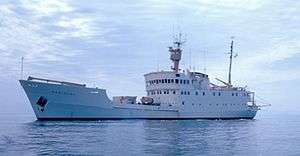 ex-CCGS Parizeau sold and renamed Destiny Empress
ex-CCGS Parizeau sold and renamed Destiny Empress ex-CCGS Ville Marie
ex-CCGS Ville Marie ex-CCGS Ernest Lapointe icebreaker
ex-CCGS Ernest Lapointe icebreaker Banfield Lifeboat
Banfield Lifeboat
Aircraft
In addition to various bases located in deep water ports, rescue stations in smaller minor ports, and eighteen ships equipped with aviation facilities like flight decks and/or hangars the CCG operates 22 helicopters. There are also eight fixed wing aircraft operated on CCG's behalf by Transport Canada. Rotary wing aircraft are used as ice reconnaissance platforms in the winter (operating from icebreakers and shore bases), while flying maintenance personnel and supplies for servicing aids to navigation year-round. Fixed wing aircraft are flown in support of the Canadian Ice Service and also conduct arctic sovereignty patrols, marine pollution surveillance and fisheries protection patrols as part of the Canadian government's National Aerial Surveillance Program.
Although there are currently 25 coast guard helicopters listed on the civil aircraft register, not all of them are operational. In December 2013, the Minister of National Defence (the Lead Minister for Search and Rescue) released the first "Quadrennial SAR Review" in order to provide a comprehensive perspective of Canada's National SAR Program (NSP). In the SAR resources section of the review it states "The Canadian Coast Guard has a total of 117 vessels and 22 helicopters stationed across the country that can deliver maritime SAR services, either in a primary or secondary role".
Rotary-wing deployment
- Atlantic Region
- Six MBB BO105s are operated in Stephenville, Newfoundland and Labrador (1), St. John's, Newfoundland and Labrador (2), Charlottetown, Prince Edward Island (1) and Halifax, Nova Scotia (2).
- Three Bell 212s are operated in St. John's (2), Halifax (1) and Saint John, New Brunswick (1).
- Central/Arctic Region
- Two MBB BO105s are operated in Quebec City, Quebec (2).
- Two Bell 206s are operated in Quebec City (1) and Parry Sound, Ontario (1).
- Two Bell 212s are operated in Quebec City (1) and Parry Sound (1).
- Western Region
- Four MBB BO105s are operated in Seal Cove, British Columbia (1) and Shoal Point, British Columbia (3).
- Two Bell 212s are operated in Seal Cove (1) and Shoal Point (1).
- One Sikorsky S-61N (C-FDOH).
Fixed-wing deployment
Most fixed wing aircraft (owned & operated by Transport Canada on behalf of CCG) are based in eastern Canadian airports with the facility at Ottawa International Airport providing the main maintenance base. A single fixed wing aircraft is based in British Columbia. In addition to the federal government aircraft, a private company Provincial Aerospace Ltd., is contracted to operate four specially modified and equipped King Air 200 aircraft in support of the National Aerial Surveillance Program (jointly funded by Transport Canada and Fisheries and Oceans Canada), from Halifax, St. John's and Comox, British Columbia.
Bases
All CCG regions operate helicopters. However, ice reconnaissance missions are primarily flown in eastern Canada, given the absence of ice surveillance requirements for the West Coast. Unlike fixed wing aircraft, helicopters can often operate directly out of CCG bases, as is the case in Quebec City and Parry Sound. The majority of CCG aircraft operate from municipal airports located near major CCG bases, as follows:
- Fixed and rotary-wing maintenance
- Fixed wing operations and maintenance
- Vancouver International Airport (YVR), Richmond, British Columbia
- Greater Moncton International Airport (YQM), Dieppe, New Brunswick
- Iqaluit Airport (YFB), Iqaluit, Nunavut
- Halifax Stanfield International Airport (YHZ), Halifax[4]
- St. John's International Airport (YYT), St. John's[4]
- Rotary-wing operations and maintenance
- Stephenville International Airport (YJT), Stephenville
- St. John's International Airport (YYT), St. John's
- 12 Wing Shearwater (YAW), Halifax
- Saint John Airport (YSJ), Saint John
- Charlottetown Airport (YYG), Charlottetown
- Canadian Coast Guard Base Parry Sound, Parry Sound
- Victoria International Airport (YYJ) and Shoal Point, Sidney, British Columbia
- Prince Rupert Airport (YPR) and CCG Base Seal Cove, Prince Rupert, British Columbia
CCG's fixed wing operations and maintenance bases are co-located with Transport Canada aviation operations facilities. Maintenance for all CCG aircraft is provided by both CCG and Transport Canada personnel.
Air search and rescue
All Canadian Coast Guard aircraft are able assist the Canadian Forces with search and rescue operations, as well as having a secondary air search and rescue role in the CCG.
| Aircraft | Origin | Type | Versions | In-Service | Notes |
|---|---|---|---|---|---|
| MBB Bo 105S | |
rotary wing | 13 | ship-based and shore-based ice surveillance, navigation aid maintenance; scheduled to be replaced in 2017. 16 delivered with 13 remaining in service as one crashed and was written off and another crashed into the Atlantic with two fatalities *In Sept 2013 another crashed in the Arctic killing the Coast Guard Captain and two Scientists. | |
| Bell 407 | |
rotary wing | 2 | shore-based ice surveillance, navigation aid maintenance; scheduled to be replaced in 2017 | |
| Bell 212 Twin Huey | |
rotary wing | 5 | shore-based ice surveillance, navigation aid maintenance; scheduled to be replaced in 2017. 6 delivered but one of these crashed in the Atlantic while carrying a sling load killing the pilot. | |
| Bell 412 EPI | |
rotary wing | 0 | 7 aircraft to be acquired to replace the Bell 212 | |
| Bell 206 JetRanger | |
rotary wing | 5 | shore-based ice surveillance, navigation aid maintenance. 6 delivered but one crashed and written off. | |
| Bell 429 | |
rotary wing | 15 | 15 in service, delivered in 2015 and 2016,[5] to replace the MBB Bo 105.[6] | |
| de Havilland Canada Dash 8 | |
fixed wing | 2 | Canadian Ice Service ice reconnaissance and oil pollution surveillance | |
| Beech Super King Air B200 | |
fixed wing | 4 | contracted by the Canadian government and owned and operated by Provincial Aerospace Limited for ice reconnaissance, marine fisheries and marine pollution surveillance[4] | |
| de Havilland Canada DHC-6 Twin Otter | |
fixed wing | 1 | marine fisheries and marine pollution surveillance | |
| de Havilland Canada Dash 7 | |
fixed wing | 1 | Canadian Ice Service ice reconnaissance and oil pollution surveillance (replaced two specially modified ice patrol Lockheed L-188 Electra's registered as CF-NAY and C-GNDZ that were operated under contract for the Canadian government by Canadian Airlines). |
 A CCG model Bo-105 onboard CCGS Louis S. St-Laurent.
A CCG model Bo-105 onboard CCGS Louis S. St-Laurent.- A CCG model Bell 212.
 A CCG model Bell 206.
A CCG model Bell 206.
Canadian Coast Guard Auxiliary
The Canadian Coast Guard Auxiliary (CCGA) does not operate an aviation branch. This role is instead provided by the volunteer Civil Air Search and Rescue Association (CASARA). Some CCGA volunteers also volunteer with CASARA or have cross-trained with the Royal Canadian Air Force (RCAF).
Retired aircraft
CCG has operated the following aircraft types which have since been retired:
- Bell 47
- Douglas DC-3
- Cessna Super Skymaster
- Grumman S-2 Tracker
- Aérospatiale Alouette III
- Sikorsky S-61
Procurement
Many larger vessels in the CCG are close to the end of their planned lifetime, having been constructed from the 1960s–1980s with no replacements in the 1990s–2000s. These include new icebreakers, patrol vessels and oceanographic science vessels.
Mid Shore Patrol Vessel Project
- The Mid Shore Patrol Vessel Project will procure nine vessels to supplement fisheries conservation and protection duties as well as marine security duties in Maritime, Newfoundland, Pacific, and Central and Arctic regions. It is expected that four of these vessels are to be tasked with marine security duties in Central and Arctic Region and will have an operating area in the Great Lakes - St. Lawrence Seaway. The initial procurement process for 12 ships was cancelled in 2008 when bids came in over budget; however, a revised bidding process was reissued in 2009.[7] On September 2, 2009, Public Works and Government Services Canada awarded a contract to Halifax Shipyards to build nine (down from the original twelve) mid-shore patrol vessels based on a 'Canadianized' version of the Damen Stan 4207 patrol vessel.[8][9][10] All vessels had been delivered to the Coast Guard by the end of 2014.
Offshore Fisheries Science Vessel Project
- The federal government announced the Offshore Fisheries Science Vessel Project in 2006 to procure vessels that will be 67 metres (220 ft) in length and be capable of carrying 22 to 26 crew as well as 19 scientists.[11] Two vessels were provided for in Budget 2006, with funding for an additional vessel added in Budget 2007.[12] The procurement process for these vessels began in September 2009,[13] and actual construction work on the three vessels in the class started in June 2015. They are projected to start entering service in 2017 with the first ship of the class to be named Sir John Franklin.
Offshore Oceanographic Science Vessel Project
- The Offshore Oceanographic Science Vessel Project is a plan to procure a single vessel that will be 90–100 metres (300–330 ft) in length capable of carrying 30 crew as well as 37 scientists. The ship will replace CCGS Hudson which has been Canada's major oceanographic research vessel for the past 40 years.[11] Funds for the project were allocated in Budget 2007.[12] The first phase of the procurement process for this vessel, along with the 3 offshore fisheries science vessels, was launched in September 2009 when the government issued a Solicitation of Interest and Qualification to identify qualified designers.[13] The construction work on this vessel is scheduled to proceed in sequence following work on the Offshore Fisheries Science Vessels.
Polar Class Icebreaker Project
- The February 2008 federal budget designated $720 million for the Polar Class Icebreaker Project[14][15] to replace CCGS Louis S. St-Laurent in FY 2017. In August 2008 the name for this project's sole vessel was announced as CCGS John G. Diefenbaker,.[16] This vessel is scheduled to start construction at the Seaspan yard in Vancouver in sequence after two new Queenston-class Joint Support Ships are built for the Royal Canadian Navy. The Joint Support Ships are projected to start construction in late 2017 and the Polar icebreaker thereafter.
Inshore Fisheries Science Vessel Project
- The 2009 federal budget announced $175 million in funding for, among other things an Inshore Fisheries Science Vessel Project which will procure three new Inshore Fisheries Science Vessels. Two 22-metre (72 ft) vessels are to be based in Quebec region, while a third 25-metre (82 ft) vessel will be based in Maritime region (in New Brunswick).[17] In June 2009, the government awarded a contract to Robert Allan Ltd. of Vancouver, British Columbia to design the vessels. The vessels are CCGS Vladykov, CCGS M. Perley and CCGS Leim.[1] In June 2012, the first vessel, CCGS Vladykov, which had been built at Meridien Maritime in Matane, Quebec, arrived at its homeport of St. John's, Newfoundland.[18]
Miscellaneous vessels and repair of existing vessels
- The funding announced in Budget 2009 also provided for the procurement of 98 small boats and barges for the CCG, as well as the life extension or repair of 40 of its larger vessels.[19][20]
Light and medium-lift helicopters
- On August 20, 2012, the Government of Canada announced a procurement of 24 new helicopters to replace the existing fleet with delivery in 2017.[21] Of these helicopters, two will eventually be assigned to the new Polar-class icebreaker John G. Diefenbaker when that vessel enters service in the 2020s. The Canadian Government announced it will buy 15 Bell 429 helicopters to satisfy the requirement for light helicopters.[22] The contracts for both the light helicopters and the medium-lift helicopters were signed in 2014-15, with the seven Bell 412 EPI ordered to fulfill the medium-lift helicopter role in April 2015. Deliveries of the Bell 429 began in March 2015 and all aircraft were delivered by March 2016.
See also
References
- 1 2 "Fleet Renewal". Canadian Coast Guard. Retrieved 28 October 2015.
- 1 2 "New offshore fisheries science ship under construction in North Vancouver". CBC News. June 24, 2015. Retrieved August 23, 2015.
- ↑ "Vancouver Shipyards to build MEMTVs and OPVs for the Canadian Coast Guard". October 10, 2013.
- 1 2 3
- ↑ "Canadian Coast Guard Accepts New Light-Lift Helicopter in Shearwater, Nova Scotia". Government of Canada. Retrieved 17 March 2016.
- ↑ "Bell Helicopter coast guard deal: 5 things to know". 13 May 2014. Retrieved 28 October 2015.
- ↑ PWGSC News Release - New Mid-Shore Patrol Vessel RFP
- ↑ "Mid Shore Patrol Vessel contract awarded to Irving Shipbuilding Inc." (Press release). Damen Shipyards Group. 2009-09-02. Retrieved 2009-09-04.
- ↑ "Contract for Canadian Coast Guard Mid-Shore Patrol Vessels: Fisheries & Oceans Announces Award for Irving Shipbuilding". Canadian American Strategic Review.
- ↑ "Contract for Canadian Coast Guard Mid-Shore Patrol Vessels: Damen Shipyards Announces $194M Award for partner, Irving". Canadian American Strategic Review. 2009-09-03. Archived from the original on 2009-09-07.
- 1 2 "Canadian Coast Guard Fleet Renewal (CCGFR) Projects". Retrieved 28 October 2015.
- 1 2 http://www.dfo-mpo.gc.ca/media/back-fiche/2007/ccg-gcc-eng.htm
- 1 2 http://www.casr.ca/doc-loi-ccg-ofsv-oosv.htm
- ↑ "Arctic icebreaker, fishing port, tax break a start: northerners". CBC News. February 27, 2008. Retrieved 2008-03-04.
- ↑ Chris Windeyer (February 29, 2008). "Feds to replace old icebreaker". Nunatsiaq News. Archived from the original on 2008-03-03. Retrieved 2008-03-04.
Ottawa will put aside $720 million this year to commission the icebreaker, which the government says will have better ice breaking capability than the Louis St. Laurent, considered the workhorse of the Coast Guard.
- ↑ Lee Berthiaume (February 27, 2008). "Icebreaker Replacement Deadline Looms: Despite $720 million in yesterday's federal budget, procurement for a new polar icebreaker will take eight to 10 years". Embassy, Canada's Foreign Policy Newsletter. Retrieved 2008-03-04.
Despite setting aside $720 million in yesterday's budget to purchase a new polar class icebreaker, the government will be cutting things close if it wants to decommission the aging CCGS Louis St. Laurent heavy icebreaker as scheduled by 2017, according to Canadian Coast Guard commissioner George Da Pont.
- ↑ http://www.dfo-mpo.gc.ca/media/back-fiche/2009/budget2009d-eng.htm
- ↑ http://www.dfo-mpo.gc.ca/media/npress-communique/2012/nl-tnl02-eng.htm
- ↑ "Government of Canada Invests in New Inshore Science Vessels". Reuters. 2009-06-04.
- ↑ "Programs and Benefits". Retrieved 28 October 2015.
- ↑ "Harper Government Launches Process to Modernize Coast Guard Helicopter Fleet". Marketwire. Retrieved 28 October 2015.
- ↑ "Bell Helicopter coast guard deal: 5 things to know". CBC News. May 13, 2014. Retrieved 4 October 2014.
| Wikimedia Commons has media related to Canadian Coast Guard ships. |
| Wikimedia Commons has media related to Canadian Coast Guard aircraft. |



